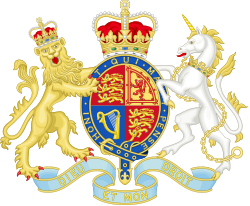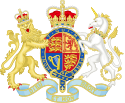Ernest Bevin
| Ernest Bevin | |
|---|---|
| Personlig information | |
| Født | 9. marts 1881 Winsford, Storbritannien |
| Død | 14. april 1951 (70 år) Westminster, Storbritannien |
| Gravsted | Westminster Abbey |
| Politisk parti | Labour Party |
| Uddannelse og virke | |
| Medlem af | General Council of the Trades Union Congress |
| Beskæftigelse | Fagforeningsperson, politiker |
| Arbejdssted | London |
| Information med symbolet | |
Ernest Bevin (9. marts 1881 – 14. april 1951) var en britisk fagforeningsmand, socialdemokratisk politiker og statsmand.
Han var arbejdsminister i den britiske regering under 2. verdenskrig. Efter krigen blev han udenrigsminister. I efterkrigstiden markerede han sig som støttespiller for USA og som en markant antikommunist. Han spillede en central rolle i oprettelsen af NATO. Bevin gik samtidig ind for en afvikling af det britiske kolonistyre i Indien og andre kolonier.
Eksterne henvisninger
| ||||||||||||||||
| Spire |
|
Medier brugt på denne side
half-plate film negative
Forfatter/Opretter: Sodacan, Licens: CC BY-SA 3.0
Royal Coat of Arms of the United Kingdom of Great Britain and Northern Ireland in the style used by the Government of Queen Elizabeth II from 1952 to 2022 (as used in all places except Scotland).
| “ | Quarterly, First and Fourth Gules three lions passant guardant in pale Or armed and langued Azure (for England), Second quarter Or a lion rampant within a double tressure flory counter-flory Gules (for Scotland), Third quarter Azure a harp Or stringed Argent (for Ireland), the whole surrounded by the Garter; for a Crest, the imperial crown Proper; for Supporters, dexter a lion rampant guardant Or crowned as the Crest, sinister a unicorn Argent armed, crined and unguled Proper, gorged with a coronet Or composed of crosses patée and fleurs de lys a chain affixed thereto passing between the forelegs and reflexed over the back also Or; Motto 'Dieu et mon Droit’ ('God and my Right') below the shield. | ” |
- PINCHES, J.H & R.V., The Royal Heraldry of England, 1974, Heraldry Today.
Forfatter/Opretter: Sodacan, Licens: CC BY-SA 3.0
Royal Coat of Arms of the United Kingdom of Great Britain and Northern Ireland in the style used by the Government of Queen Elizabeth II from 1952 to 2022 (as used in all places except Scotland).
| “ | Quarterly, First and Fourth Gules three lions passant guardant in pale Or armed and langued Azure (for England), Second quarter Or a lion rampant within a double tressure flory counter-flory Gules (for Scotland), Third quarter Azure a harp Or stringed Argent (for Ireland), the whole surrounded by the Garter; for a Crest, the imperial crown Proper; for Supporters, dexter a lion rampant guardant Or crowned as the Crest, sinister a unicorn Argent armed, crined and unguled Proper, gorged with a coronet Or composed of crosses patée and fleurs de lys a chain affixed thereto passing between the forelegs and reflexed over the back also Or; Motto 'Dieu et mon Droit’ ('God and my Right') below the shield. | ” |
- PINCHES, J.H & R.V., The Royal Heraldry of England, 1974, Heraldry Today.






